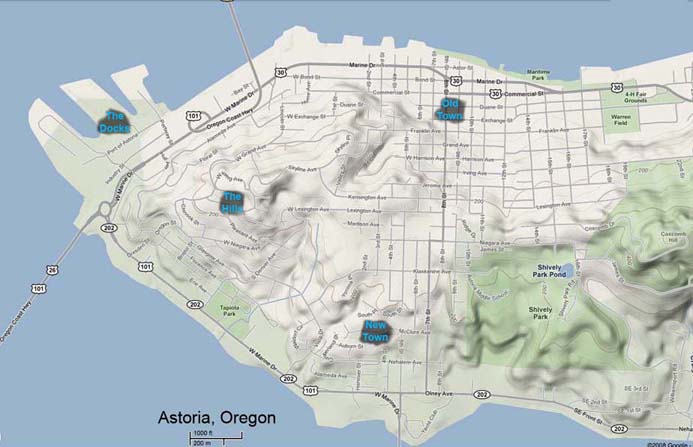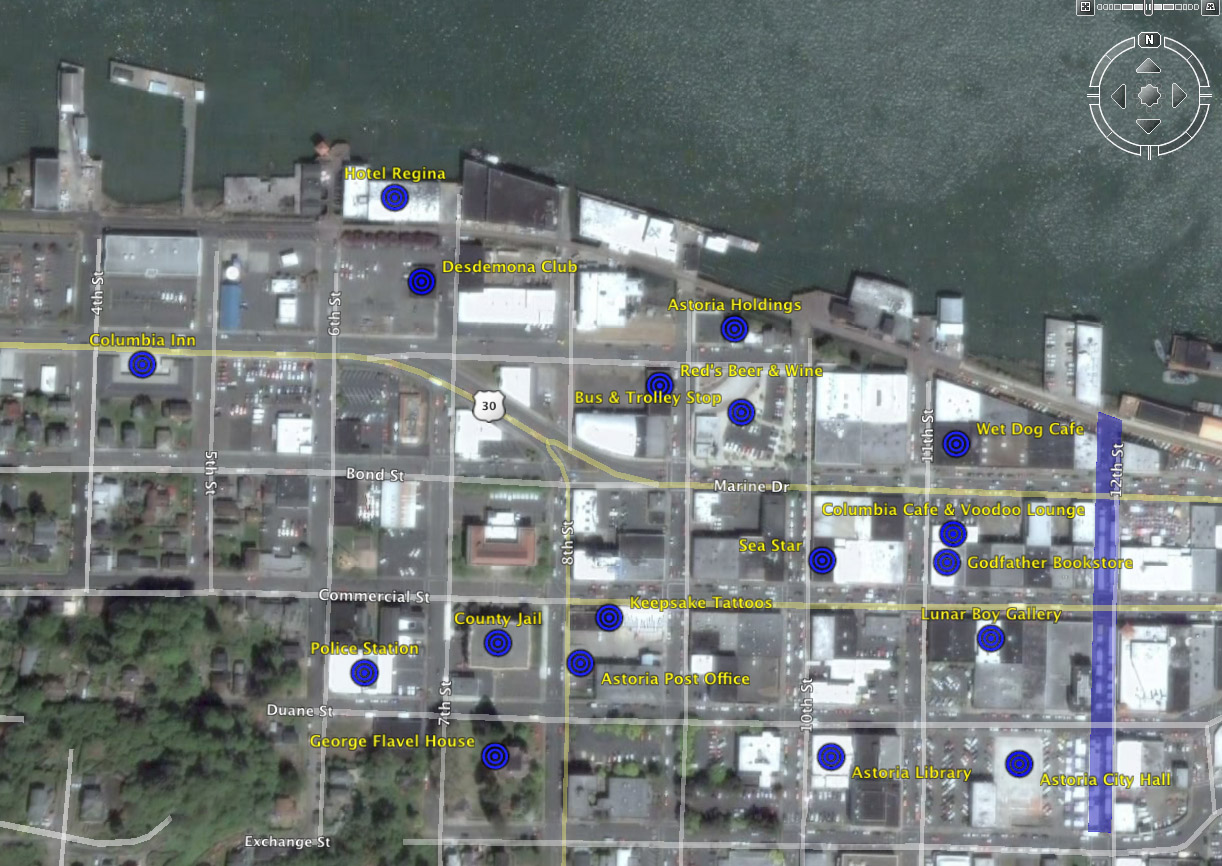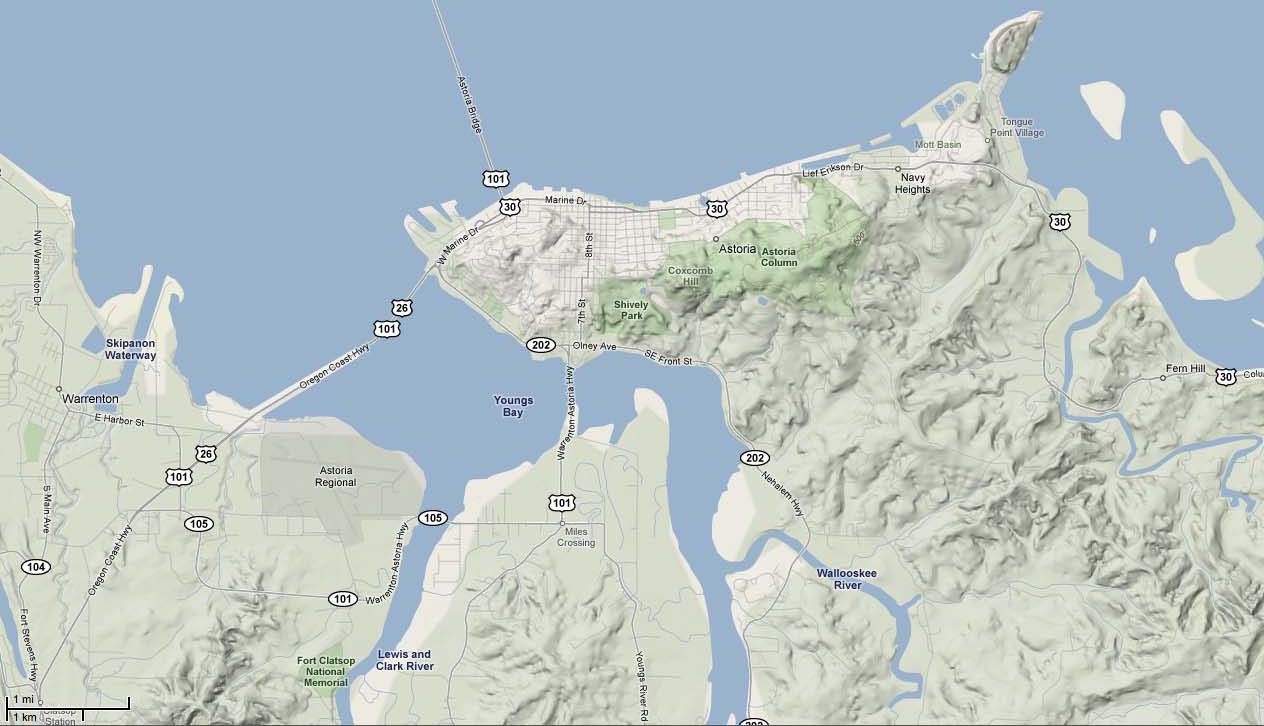Difference between revisions of "Astoria"
| Line 30: | Line 30: | ||
| http://www.oakthorne.net/pics/wiki/gate-gods/Astoria-OldTown.jpg | | http://www.oakthorne.net/pics/wiki/gate-gods/Astoria-OldTown.jpg | ||
|} | |} | ||
| − | Old Town Astoria is just what it sounds like - an area of town that was among the first settled. Old Town sees perhaps the greatest concentration of tourists, given its proximity to the boardwalk. | + | Old Town Astoria is just what it sounds like - an area of town that was among the first settled. Old Town sees perhaps the greatest concentration of tourists, given its proximity to the boardwalk. Old Town is well-maintained and has a friendly vibe and somewhat of a youth-centric, counter-culture flavor to it. |
* '''The [[Hotel Regina]]''' has been shut down for about as long as anyone in Astoria can remember. It is a local edifice, with its carved wooden doors and boarded-up windows. Children in Old Town have told one another ghost stories about it for years, and despite its abandonment, no one has ever thought of proposing it be torn down - it is too much of a local landmark for that. | * '''The [[Hotel Regina]]''' has been shut down for about as long as anyone in Astoria can remember. It is a local edifice, with its carved wooden doors and boarded-up windows. Children in Old Town have told one another ghost stories about it for years, and despite its abandonment, no one has ever thought of proposing it be torn down - it is too much of a local landmark for that. | ||
* '''The [[Columbia Inn]]''', a small busy motel in the middle of Old Town. | * '''The [[Columbia Inn]]''', a small busy motel in the middle of Old Town. | ||
Revision as of 05:07, 25 October 2008

|
Population: 10,045
Class: Middle Class (primarily)
A small town in the northwest corner of Oregon along the coast, Astoria is an old fishing and fur-trading settlement on land that was originally occupied by the Clatsop tribe. Named for its first millionaire, John Jacob Astor, Astoria grew up around the fort founded by Astor's fur trading company in 1810. It also boasts a deep water port that sees very little shipping trade, though it still maintains a decent fishing industry. It is also a port of call for a number of cruise lines sailing up and down the West Coast. This port attracted a number of immigrants in the late Nineteenth Century, mainly Scandinavians (particularly Finns, who worked the fisheries) and Chinese (who found work in the canneries).
Contents
Facts & Figures
Astoria is a city of 10,000 people on the Columbia River, just a few miles from the Pacific Ocean located in Clatsop County. It is surrounded by the beauty of the forest, mountains, 3 rivers and the sea. Because of its steep hills and beautiful Victorian homes, Astoria has been Called the “Little San Francisco of the Pacific Northwest.” Just across Youngs Bay is Warrenton, a city of 4,500, that encompasses Fort Stevens State Park and its broad, clean ocean beaches.
Astoria and Warrenton have a marine climate, which means the summers are cool, with highs around 70, and the winters are mild, with few nights of freezing temperatures. The area gets about 75 inches of rain per year, which accounts for its vivid greenness and crystal clear air. Winter storms can be dramatic with winds reaching 70 to 100 miles per hour on the ocean bluffs. The area has a strong Scandinavian heritage.
History
In May, 1792, American Captain Robert Gray sailed his 230-ton Columbia Rediviva between Point Adams in what is now Oregon and Cape Disappointment in what is now Washington to first enter the Columbia River. Ten years later, President Thomas Jefferson asked his personal secretary, Army Captain Meriwether Lewis, to lead an expedition to the Pacific to find “...whether the Columbia, Oregen, Colorado, or any other river may offer the most direct and practicable water communication across this continent for the purposes of commerce”.
The Lewis and Clark Expedition left Pittsburgh August 31, 1803. The Corps of Discovery entered the Lower Columbia River in November of 1805 and stayed through March 1806. They “wintered over” at Fort Clatsop, where it rained all but 12 days, hunting, making moccasins and other clothing, trading with the Clatsop, Tillamook, and Chinook Indians, and working on their journals.
In 1811, five years after the departure of Lewis & Clark, John Jacob Astor, a New York financier, sent fur traders aboard the ship Tonquin to establish a trading post. They built Fort Astoria on a site now preserved as a monument in the downtown area.
Well over 200 major shipwrecks have occurred near the mouth of the Columbia River – known for a century as “The Graveyard of the Pacific.” One, the Peter Iredale of 1906, is still visible on the beach at Fort Stevens State Park. Native Americans lived in the area for an estimated 10,000 years before Captain Gray’s arrival.
Links of Interest
Old Town

|
Old Town Astoria is just what it sounds like - an area of town that was among the first settled. Old Town sees perhaps the greatest concentration of tourists, given its proximity to the boardwalk. Old Town is well-maintained and has a friendly vibe and somewhat of a youth-centric, counter-culture flavor to it.
- The Hotel Regina has been shut down for about as long as anyone in Astoria can remember. It is a local edifice, with its carved wooden doors and boarded-up windows. Children in Old Town have told one another ghost stories about it for years, and despite its abandonment, no one has ever thought of proposing it be torn down - it is too much of a local landmark for that.
- The Columbia Inn, a small busy motel in the middle of Old Town.
- Keepsake Tattoos, a piercing and tattooing parlor.
- Red's Beer & Wine, the local all-night liquor store.
- Wet Dog Cafe and Astoria Brewing, a small greasy-spoon burger place and brew pub that seems a little too run-down to attract many tourists, but a favorite of the locals.
- Old Town Police Department, the police headquarters for Old Town.
- Astoria Library, the oldest library in Astoria.
Area Stats
- Physical: Access +3, Safety +1. Old Town has plenty of navigable streets, broad sidewalks and a predictable street layout. Though it isn't overtly dangerous, the presence of a wide variety of partying tourists and the accumulation of most of the town's nightspots means that safety isn't always an assurance in Old Town (though it's rarely danger of any kind of true severity).
- Mental: Information +2, Awareness +1. Old Town is definitely part of the information age - many of the coffee shops, brew pubs and hotels maintain WiFi hotspots, and billboards and signage is clear and to the point here. Most people are used to strange faces here, and though they don't generally bother anyone, they do keep an eye out for the things that go on.
- Social: Prestige +1, Stability +3. Though it is considered a tourist trap, Old Town is still a nice place to live, and its locals watch out for one another.
- Sanctum Qualities: Up to Size 3. The buildings of Old Town are divided and sub-divided such that it's impossible to find a truly large Sanctum.
The Docks

|
The industrial and shipping center for Astoria, the docks are fairly run-down. Composed primarily of canneries, shipyards and warehouses, no one but the genuinely destitute actually live in the Docks area of town. There are a few run-down bars and scummy motels (whose main patrons are sailors in overnight who prefer not to bunk on their ships), as well as a few restaurants (mostly of the fast food and greasy diner variety).
At night, the docks are pretty abandoned, other than the occasional drunk sailor or dockhand stumbling home from the bar. The area has a reputation as a fairly dangerous one at night, so the police tend to pick up their patrols in the evenings. Despite this, no one in their right mind comes here at night - unless they are looking for trouble of some kind. Rumors say that smugglers coming in from Asia sometimes berth here, using the small Oregon town as the point of entry into the United States.
Area Stats
- Physical: Access +2, Safety -1. The docks feature plenty of roads, and ways in and out of the area, though everyone acknowledges that they can be dangerous, especially after dark.
- Mental: Information +0, Awareness -3. No one is interested in anyone else's business here, and everyone keeps to themselves.
- Social: Prestige -3, Stability -2. No one actually comes from the docks, and those who do are the few homeless Astoria has attracted. In the docks, it's basically every man for himself.
- Sanctum Qualities: Maximum Security 3. Though there are plenty of large buildings in the docks, the security of the area is fairly light. No one protects the area too stringently, and the resources just aren't available to do so in a Sanctum without drawing undue attention.
The Hills

|
Most people who live in houses, but who can't afford the elitism of New Town live out in the Hills. Houses dot the hillsides in this area and provide a fantastic view of the ocean. These houses aren't always in the best of shape, however, and the residences here range from nice Victorians and Queen Annes that would be right at home in New Town, to crappy little ramshackle houses more reminiscent of a redneck backwater than a lovely coastal town.
Area Stats
- Physical: Access +X, Safety +X. X
- Mental: Information +X, Awareness +X. X
- Social: Prestige +X, Stability +X. X
- Sanctum Qualities: X. X
New Town

|
The most gentrified area in Astoria, New Town is a place frequently filmed when a movie needs to depict a lush Pacific Northwest coastal town. Trendy businesses and restored Victorian houses dot the area, against a backdrop of green hills and ocean vistas.
Area Stats
- Physical: Access +1, Safety +1. New Town has decently maintained streets and one or two cab companies, but most people need cars or at least bicycles to get around effectively. It is moderately patrolled and people have some measure of protection, but not much happens here, so the police aren't too curious nor the citizenry too diligent about locking doors or maintaining security systems.
- Mental: Information +3, Awareness -1. Though the physical lay of the land doesn't have much in the way of open line of sight (too much foliage and hills for that), security cameras and a lassitude that leaves street lights or sidewalk lamps burnt out a little too long sometimes, it's a small town, and so everyone seems to know everything.
- Social: Prestige +2, Stability +3. New Town is where most of the gentrification in Astoria has occurred, and so the houses out here are more expensive. The people who live in this part of town know one another fairly well, too.
- Sanctum Qualities: Up to Size 3. There aren't many buildings larger than a sizeable Victorian in New Town.
Edges of Town
- 1: The Astoria Column, a 125-foot tall painted column with an observation deck on top that sits on a hill overlooking Astoria.
- 3: Clatsop Community College, a public two-year college that serves northwest Oregon and southeast Washington.
Nearby Areas

|
- Astoria Regional Airport, a small municipal airport
- CGAS Astoria, a Coast Guard Air Station located at the Astoria Regional Airport
- Warrenton, a nearby town (pop. 4300)
- Other Small Towns
- All of the following have populations of less than 500, and many of only a few hundred
- Hammond, a small town absorbed by Warrenton.
- Navy Heights
- Tongue Point Village
- Youngs River & Bay
- Fern Hill
- Svensen
- Olney
- Lilleas & Estoos
- Clatsop Spit, a massive sand flat responsible for many shipwrecks.
- The Peter Iredale shipwreck